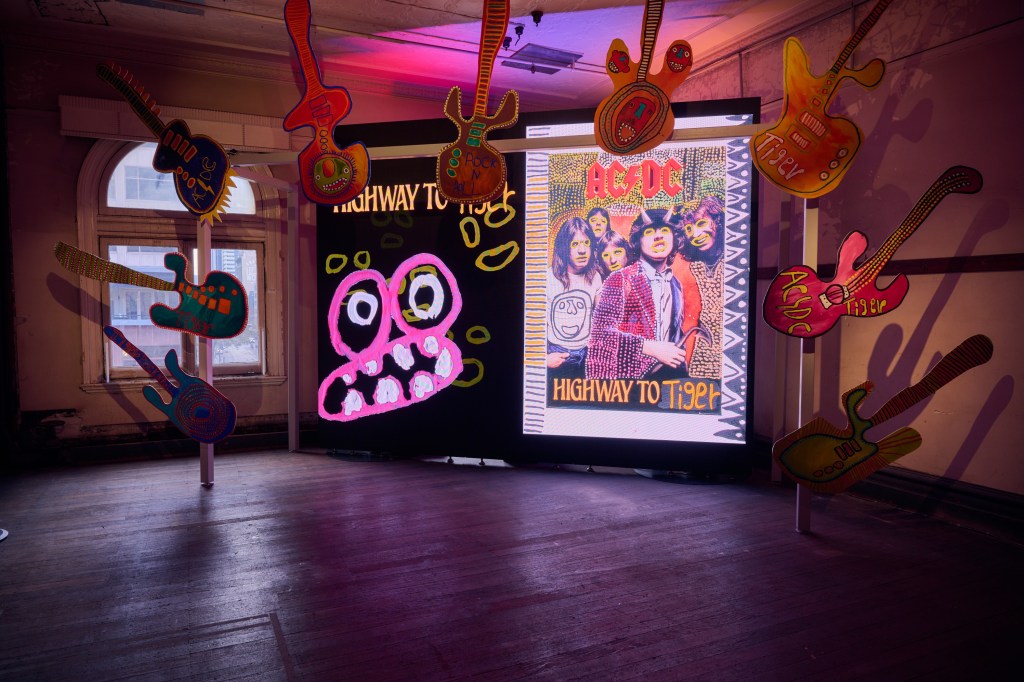Aboriginal and Torres Strait Islander readers are advised that the following review contains names of deceased persons.
Shadow Spirit, presented as part of RISING festival and curated by Kimberley Moulton, is an immersive exhibition featuring 30 Aboriginal and Torres Strait Islander artists from around the country. It is currently showing above Finders Street Station in Naarm/Melbourne.
Shadow Spirit has an intricate curatorial narrative that weaves its way throughout the exhibition with each artist responding to the themes of ‘Weaving Time’, ‘Spirit Ecologies’, ‘The Guides’, ‘Absent Presence’ and ‘The In-Between’. The themes speak to First Nations’ unique knowledges around deep time, spirituality and the ongoing connection to the land and the cosmos.
The concept of deep time is best experienced through an artwork by Rene Wanuny Kulitja (NT) titled Tiirtjingalpai – Practising Care for the Spirits of the Dead (2023). In it a looping video and light installation transports the audience to Pitjantjatara country, where red sand and shrubbery create a sense of being deep in the desert. The pace of the work feels more circular than linear, constantly ebbing and flowing, anchored by Kulitja’s presence, sitting calmly in front of a beautiful rock formation, the breeze in her hair. Kulitja’s work reminds us to be present and to sense the ever-changing spirits that are present in the land.
The ballroom is dedicated to the Mulka Project’s Rarrirarri (2023) in honour of master Yolŋu artist Mrs M Wirrpanda (1947-2021). Her family have given permission to use her name and have also created a beautiful soundscape to accompany the installation. A large termite hill stands in the centre of the old ballroom with projections of insects, plants and shrubs creating a sense that the artwork is actually growing directly out of the earth. Spirit oozes from this work where collective output is clearly evident and this community collaboration speaks directly to the soul.
Playfulness has found its way into the exhibition through Warwick Thornton’s video work Way of the Ngangkari (2023), featuring Ngangkari healers holding traditional objects illuminated like Star Wars light sabres. Tiger Yaltangki and Jeremy Whiskey’s ROCK N ROLL (2023) extends on this sense of playfulness with a room dedicated to a love of colour and AC/DC, depicted alongside playful spirits that Yaltangki reminds us can bring joy and humour to our lives. His work is a breath of fresh air amid an exhibition full of ominous soundscapes.

Julie Gough’s Invoke/Inverse (2023) is hauntingly moving and it stayed with this reviewer for a while after leaving the exhibition. Her use of kinetic puppetry is eerie, creating a series of shadows overlaid onto images of lutruwita/Tasmania. A wooden watchtower with wooden benches aims to represent colonial surveillance, but this reviewer felt more like they were in a bathhouse or sauna. The pace and movement of the shadows walking across the land is mesmerising and deeply saddening as the ghosts of Gough’s ancestors still walk the lands of lutruwita.
While there is no fault in the cinematography, lighting or composition in Hayley Millar Baker’s short film The Umbra (2023), it is ultimately starved of tension – something that the moving image craves. The young women depicted seem to be holding their positions as opposed to breathing into the moment. Similarly Brian Robinson’s projection work Zugubal: The Winds and Tides set the Pace (2023) in Torres Strait Islander linocut style, which is beautifully made, but this reviewer found the audio to be overly didactic and monotone in its execution. This work would be better suited to a natural history museum due to its overly educational tone.
Vicki Couzens’ PEERT KOOROOK – Guardians of Womens Country (2023), in the form of a large bandicoot sculpture, feels mismatched with the black and white imagery being projected onto it. The mixture of the crude finish on the bandicoot and the grainy quality of the projection doesn’t mesh well and overshadows the spirit of the bandicoot itself.
Dylan Mooney’s animation Message In My Dreams (2023) is charming in a video-game style, but the inflatable serpent overhead does little but accentuate the taped-up manhole above it.
Read: Exhibition review: CHAGALL, Jewish Museum of Australia
Overall, Shadow Spirit is a fascinating and wonderful attempt at bringing First Nations’ rich experiences of spirituality to the medium of immersive media art. RISING should be commended for providing a space for 30 Aboriginal and Torres Strait Islander artists to utilise a medium that can be expensive, labour intensive and inaccessible.
While the works don’t feel particularly bold or groundbreaking, it is a wonderful window into what is possible for the future merging of First Nations culture with immersive media art. Shadow Spirit reminds us that our spirits are linked directly to Country and, if we are to strengthen our spirit, we must be present with and care for the Land and all its inhabitants.
Shadow Spirit is presented as part of the RISING festival 2023 and is on view until 30 July at Flinders Street Station; ticketed.
This article is published under the Amplify Collective, an initiative supported by The Walkley Foundation and made possible through funding from the Meta Australian News Fund.





